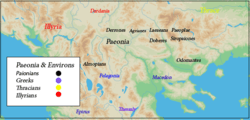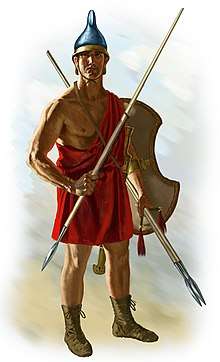Agrianes
The Agrianes (Ancient Greek: Ἀγρίανες, Agrianes or Ἀγρίαι Agriai) or Agrianians, were a tribe whose country was centered at Upper Strymon, in present-day western Bulgaria, and also held areas of southeasternmost Serbia in the ancient Roman provinces of Dacia Mediterranea, at the time situated north of the Dentheletae. In the times of Philip II, the territory of the Agrianes was administered by Pella. They were crack javelin throwers and an elite unit of Alexander the Great's light infantry, who fought under the command of General Attalus.

Etymology and tribal belonging
Their name in Ancient Greek was Ἀγρίανες.[1] The ethnonym is of Indo-European origin, from *agro- "field" (cf. Lat. ager, Gk. ἀγρός agros, Eng. acre).[2] An early name of the Rhodopes was Achrida, which may be a cognate.
Herodotus described them as a tribe of Paeonia,[3] together with the Odomanti and Doberes in the vicinity of Pangaeum. The only writer who describes the Agrianes as Thracians is Theopompus.[4]
Geography
Their country was centered at Upper Strymon, in present-day westernmost Bulgaria, and also held areas of southeasternmost Serbia,[5] at the time situated north of the Dentheletae. In the times of Philip II, the territory of the Agrianes was administered by Pella.[6] An ethnocultural region called "Graovo" remains in Pernik Province.[7]
Military

The peltasts raised from the Agrianes were the elite light infantry of the Macedonian army. They were often used to cover the right flank of the army in battle, being posted to the right of the Companion cavalry, a position of considerable honour. They were almost invariably part of any force on detached duty, especially missions requiring speed of movement.[8]
Peltasts were armed with a number of javelins and a sword, carried a light shield but wore no armour, though they sometimes had helmets; they were adept at skirmishing and were often used to guard the flanks of more heavily equipped infantry. They usually adopted an open order when facing enemy heavy infantry. They could throw their javelins at will at the enemy and, unencumbered by armour or heavy shields, easily evade any counter-charges made by heavily equipped hoplites. They were, however, quite vulnerable to shock-capable cavalry and often operated to particular advantage on broken ground where cavalry was useless and heavy infantry found it difficult to maintain formation.[9][10]
History
They are first mentioned regarding the Megabazos' campaign in 511 BC.[2] In 429 BC they were subject to the Odrysian kingdom[11] and later, as early as 352 BC, they became allies of Philip of Macedonia.[12]
They fought under king Langarus with the Macedonians against the Triballians in 335 BC[13] and succeeded in protecting the lands of Alexander and were thus rewarded with the right to govern themselves, a move that led to a long-lasting and most reliable alliance. At the Battle of Gaugamela (331 BC), during Alexander the Great's conquest of Persia, their contingent of peltasts numbered 1,000 men. During the time of the Seleucid Empire, a crack unit of Antiochus' Agrianes was brigaded together with Persians at Raphia. Contingents from the Agrianes and the Penestae, numbering 800 and 2,000 men respectively, were a part of the garrison of Cassandreia at the time of the Third Macedonian War.[14]
References
- "Agrianes: Greece (Paeonia)". Trismegistos. Retrieved 23 November 2016.
- Shea, John (1997-01-01). Macedonia and Greece: The Struggle to Define a New Balkan Nation. p. 52. ISBN 9780786402281.
- Wheeler, James Talboys (1854). The Geography of Herodotus ...: Illustrated from Modern Researches and Discoveries. p. 130.
- The Cambridge Ancient History: pt. 1. The prehistory of the Balkans; and the Middle East and the Aegean world, tenth to eighth centuries B.C. Cambridge University Press, 1991. University of Minnesota/ The only writer who describes the Agrianes (under the form Agrii) as Thracians, is Theopom- pus (f 257(a)), but his evidence, isolated as it is, carries less weight.
- Yenne, Bill (2010-04-13). Alexander the Great: Lessons from History's Undefeated General. ISBN 9780230106406.
The Agrianians were a Thracian people from the area that is now southern Serbia
- Hammond, Nicholas Geoffrey Lemprière (1988). A History of Macedonia: 336-167 B.C. p. 39. ISBN 9780198148159.
- Vintilă-Ghiţulescu, Constanţa, ed. (2011). From Traditional Attire to Modern Dress: Modes of Identification, Modes of Recognition in the Balkans (XVIth-XXth Centuries). Cambridge Scholars Publishing. p. xv. ISBN 9781443832632. Retrieved 23 November 2016.
- Ashley, p. 45-46.
- Connolly, pp. 48-49.
- Sidnell, pp. 57-59
- Herodotus; Macan, Reginald Walter (1908). Herodotus, the Seventh, Eighth, & Ninth Books: Pt. I. Introduction. Book VII. (text and commentaries).
- Chatzopoulos, Miltiadēs V; Loukopoulou, Louïza D (1980). Philip of Macedon.
- Darko Gavrovski, “TETOVO ANTIQUITIES - Polog valley from Prehistory to 7th century AD, with special emphasis on the Tetovo region”, Tetovo, 2009. English summary on: "Index". Archived from the original on 2009-08-04. Retrieved 2009-06-26.
- Livy (2007-11-08). Rome's Mediterranean Empire: Books 41-45 and the Periochae. ISBN 9780192833402.
Bibliography
- Ashley, J.R. (2004) The Macedonian Empire: The Era of Warfare Under Philip II and Alexander the Great, 359-323 B.C. McFarland.
- Connolly, P. (1981) Greece and Rome at War. Macdonald Phoebus, London. ISBN 1-85367-303-X
- Sidnell, P. (2006) Warhorse: Cavalry in Ancient Warfare, Continuum, London.
- Viktorija Sokolovska, Pajonskoto Pleme Agrijani i vrskite so Damastion, Maced. acta Archaeologica 11, Skopje 1990, 9-34. (with summary in French).
- Viktorija Sokolovska, The Coinage of Agrianes, MACEDONIAN NUMISMATIC JOURNAL no. 2, Skopje 1996, 13-22.